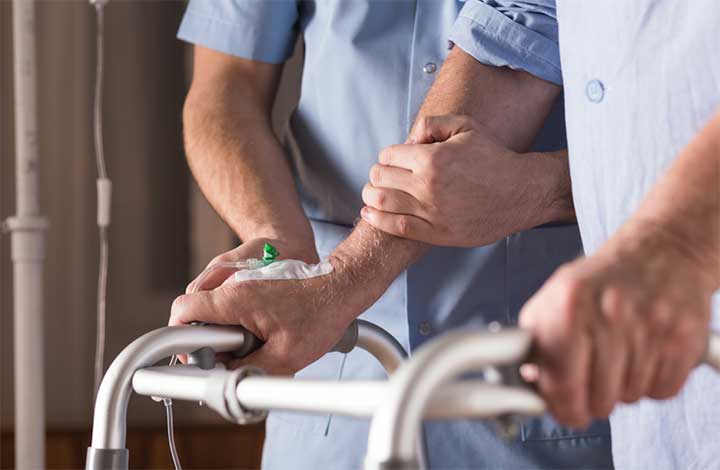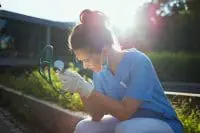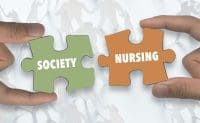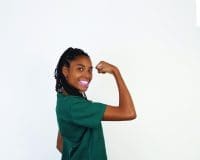Over the last 3 years, important new evidence has emerged about safe patient handling. You can apply this evidence at the bedside to help protect yourself and your patients from injury. Below we describe the top 10 new findings and their potential impact.
1. Back pain and injuries in nurses are widespread.
The evidence: Despite recent progress in protecting healthcare workers from musculoskeletal disorders (MSDs) caused by manual patient handling, these injuries are still common throughout the world, causing pain and lost time. In some cases, MSDs force nurses to change careers.
Potential impact: Because MSDs result from repeated trauma, the burden of frequent manual handling of heavy loads eventually leads to disabling injuries among direct patient caregivers.
2. Nurses should not lift more than 35 lb.
The evidence: Under ideal conditions, the maximum limit for manual patient handling is 35 lb. If a nurse is required to lift a patient or a limb weighing more than 35 lb, mechanical assistance is required. Less-than-ideal conditions include lifting while in an awkward posture and bearing the load far from the body.
Potential impact: Using equipment for loads weighing more than 35 lb reduces pain and injury for caregivers and increases patient safety during handling.
3. How much nurses can push or pull safely depends on their weight.
The evidence: A recent study found that 20% of a nurse’s weight is the limit for manually pushing and pulling loads. Thus, a 130-lb nurse who pushes a load greater than 26 lb is exceeding acceptable levels.
Potential impact: Nurses should use mechanical assistance, such as powered stretchers, to reduce MSD risk when pushing occupied beds, stretchers, or heavy equipment.
4. Safe patient-handling programs reduce injuries to nurses.
The evidence: Multicomponent patient-handling interventions are effective in reducing MSDs in nurses. Required program elements include commitment by management to reducing injuries, minimal manual lifting policies, patient assessment strategies, and modern lifting and transfer equipment.
Potential impact: Nurses will enjoy longer careers and reduced disability if they choose employers who have multifaceted safe patient-handling and movement (SPHM) programs.
5. Specialty practice areas have customized SPHM guidelines.
The evidence: The National Association of Orthopaedic Nurses, Patient Safety Center of Inquiry at the James A. Haley Veterans Administration Medical Center in Tampa, National Institute for Occupational Safety and Health (NIOSH), and American Nurses Association (ANA) identified high-risk tasks in orthopedics and developed four additional algorithms and a clinical tool to reduce injury risk. Similarly, the Association of Perioperative Registered Nurses formed a task force of experts to develop clinical tools that could reduce work-related injuries from patient handling. Experts in other specialty care areas, such as pediatrics, obstetrics, and critical care, also have made SPHM recommendations.
Potential impact: In addition to the guidelines developed for medical-surgical and long-term care settings (www.visn8.va.gov/patientsafetycenter/safePtHandling/default.asp), nurses working in almost any setting can find guidelines to help protect themselves and patients from injury.
6. Very heavy patients threaten nurses’ backs, necks, and knees.
The evidence: A study found that the percentage of patient-handling injuries from moving morbidly obese patients in a large Level I trauma center was out of proportion to the percentage of heavy patients. Patients with a body mass index of 35 kg/m made up only 10% of the patient population but were associated with 30% of staff injuries related to patient handling. Strikingly, 80% of those injured were registered nurses and nursing aides.
Potential impact: With an increasing census of heavier patients due to widespread obesity, even such tasks as applying compression stockings or positioning patients’ legs for bedpan use can injure nurses. The leg of a 250-lb patient weighs about 39 lb, above the safe limit for manual handling.
7. New technology is solving old problems.
The evidence: Exciting new advances in technology now provide mechanical assistance for getting patients out of vehicles—a task that has been especially hazardous for emergency department nurses. Ceiling lifts have been expanded to turn patients in bed and other devices have been designed to reduce patient-handling risks.
Potential impact: Use of specialized devices can reduce caregiver and patient risk.
8. Nursing schools can teach tomorrow’s nurses how to work safely.
The evidence: NIOSH has released curricular materials developed in conjunction with ANA and the Veterans Administration Patient Safety Center of Inquiry so that schools can offer evidence-based education on SPHM. To download the curriculum module, visit www.cdc.gov/niosh/docs/2009-127.
Potential impact: Newly graduated nurses will expect healthcare employers to provide workplace protections against MSDs. The disciplines of physical therapy and occupational therapy are following nursing’s lead by developing their own curricular modules.
9. Healthcare facilities have a new guide for assessing SPHM equipment needs during remodeling or new construction.
The evidence: For the first time, building designers have guidelines for assessing and incorporating lifting equipment needs during design and building of hospitals (www.fgiguidelines.org/interim_pubs.html).
Potential impact: If healthcare facilities follow these guidelines, they will no longer need to undertake the expensive and often inadequate retrofitting of patient rooms, bathrooms, and hallways to accommodate modern equipment.
10. Seven states have laws to protect nurses from patient-handling injuries.
The evidence: Illinois, Maryland, Minnesota, New Jersey, Rhode Island, Texas, and Washington have established comprehensive laws protecting nurses and patients from the risks of manual patient handling. National legislation is under consideration to require the Occupational Safety and Health Administration to enact an SPHM standard as well (www.nursingworld.org/MainMenuCategories/ANAPoliticalPower/State/StateLegislativeAgenda/SPHM/Enacted-Legistation.aspx).
Potential impact: Legislation will require healthcare employers to provide ergonomic assessment of workplace risks and SPHM equipment to reduce these risks.
Selected references
Chaffin DB, Andersson GGJ, Martine BJ, eds. Occupational Biomechanics. Hoboken, NJ: Wiley-Interscience; 2006.
Daraiseh NM, Cronin SN, Davis LS, Shell RL, Karwowski W. Low back symptoms among hospital nurses, associations to individual factors and pain in multiple body regions. Int J Ind Ergon. 2010;40(1):19-24.
de Castro AB, Cabrera SL, Gee GC, Fujishiro K, Tagalog EA. Occupational health and safety issues among nurses in the Philippines. AAOHN J. 2009;57(4):149-157.
Karahan A, Kav S, Abbasoglu A, Dogan N. Low back pain: prevalence and associated risk factors among hospital staff. J Adv Nurs. 2009;65(3):516-524. doi: JAN4905 [pii] 10.1111/j.1365-2648.2008.04905.x.
Knapik GG, Marras WS. Spine loading at different lumbar levels during pushing and pulling. Ergonomics. 2009;52(1):60-70. doi: 909781975 [pii] 10.1080/00140130802480828.
Menzel NN, Hughes NL, Waters T, Shores LS, Nelson A. Preventing musculoskeletal disorders in nurses: a safe patient handling curriculum module for nursing schools. Nurs Educ. 2007;32(3):130-135. doi: 10.1097/01.NNE.0000270227.61414.79 00006223-200705000-00011 [pii].
Mitchell T, O’Sullivan PB, Smith A, et al. Biopsychosocial factors are associated with low back pain in female nursing students: a cross-sectional study. Int J Nurs Stud. 2009;46(5):678-688. doi: S0020-7489(08)00312-X [pii] 10.1016/j.ijnurstu.2008.11.004.
Nelson A, Motacki K, Menzel N, eds. The Illustrated Guide to Safe Patient Handling and Movement. New York, NY: Springer; 2009.
Nelson A, Waters TR, Menzel NN, et al. Effectiveness of an evidence-based curriculum module in nursing schools targeting safe patient handling and movement. Int J Nurs Educ Scholarsh. 2007;4:Article26. Epub December 2007. doi: 10.2202/1548-923X.1486.
Randall SB, Pories WJ, Pearson A, Drake DJ. Expanded Occupational Safety and Health Administration 300 log as metric for bariatric patient-handling staff injuries. Surg Obes Relat Dis. 2009;5(4):463-468. doi: S1550-7289(09)00051-3 [pii] 10.1016/j.soard.2009.01.002.
Sedlak CA, Doheny MO, Nelson A, Waters TR. Development of the National Association of Orthopaedic Nurses guidance statement on safe patient handling and movement in the orthopaedic setting. Orthop Nurs. 2009;28(suppl 2):S2-S8.
Sikiru L, Shmaila H. Prevalence and risk factors of low back pain among nurses in Africa: Nigerian and Ethiopian specialized hospitals survey study. East Afr J Public Health. 2009;6(1):22-25.
Tullar JM, Brewer S, Amick BC 3rd, et al. Occupational safety and health interventions to reduce musculoskeletal symptoms in the health care sector. J Occup Rehabil. Epub March 10, 2010. doi: 10.1007/s10926-010-9231-y.
U.S. Department of Veterans Affairs. VISN 8 Patient Safety Center of Inquiry. Technology resource guide, 2010. www.visn8.va.gov/patientsafetycenter/. Accessed June 16, 2010.
Waters TR. When is it safe to manually lift a patient? AJN. 2007;107(8):53-58; quiz 59. doi: 10.1097/01.NAJ.0000282296.18688.b1 00000446-200708000-00030 [pii].
Nancy N. Menzel is an associate professor at the University of Nevada, Las Vegas School of Nursing in Las Vegas. Audrey L. Nelson is the director of VISN 8 Patient Safety Center of Inquiry at James A. Haley Veterans Hospital in Tampa, Florida.



















1 Comment.
Excellent. Is there further research available more recently that you recommend?